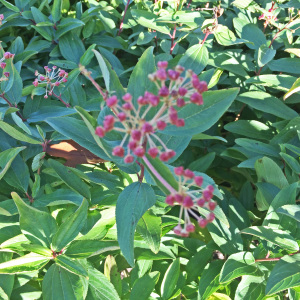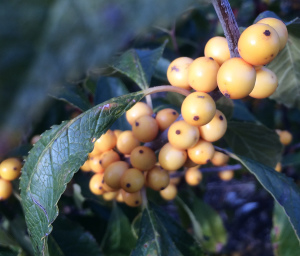I will claim fame as a perennial guru but what I don’t know about woody plants, particularly trees, would fill several books. Fortunately, I have had an incredible mentor in Bill Hendricks, the owner of Klyn Nurseries (wholesale only). Bill is a plant-a-holic like me and he is always searching for the next best plant and hybridizing some of his own. What makes him so special is that he loves to share what he knows. This week I spent three and a half hours with him while he pointed out plants that landscape designers and gardeners should be using. I want to share some of these plants with you but there are so many that I can’t possibly include all of them in this post. That means, of course, that there will be more to follow.
Today, I am going to concentrate on some of the ones with gorgeous fall fruits. Ceanothus americanus, the New Jersey Tea. Clusters of delicate white flowers appear in June but I think the best attribute of this plant is the pink fruits.This versatile native grows three to four feet tall but a bit wider. It grows best in sun and well-drained soils but tolerates some shade and drought. In fact, its thick roots contribute to its drought tolerance but it would be difficult to transplant.

Viburnum dilatatum ‘Michael Dodge’ flowers – awaytogarden.com
The Viburnum scare is dissipating. That doesn’t mean that the beetle is gone, only that the severe infestations are probably gone. The beetle does seem to disregard certain species and V.dilatatum is one of them. The cultivar ‘Michael Dodge’ needs to be used much more for its fall color. Its foliage becomes orange to red and the abundant, large clusters of berries are apricot. You can see them from quite a distance, more so than clusters of red berries. It will have large white clusters of flowers in May. A larger shrub at eight to ten feet tall by six to eight feet wide, this is one to use at the back of a border or as a tall hedge.
The last plant I want to mention is Ilex verticillata, Winterberry, a deciduous holly best known for its fall fruits. Although it will grow in sun or partial shade, it fruits best in full sun. A native of swampy habitats, it does quite well with average moisture. Be sure to purchase at least one male to pollinate the female of your choice. The male cultivars have different names than the fruiting females.
The cultivars with red fruits are the most frequently purchased but seeing mature plants in the landscape makes me question why the yellow berried cultivars aren’t planted more often. The red ones are beautiful up close but from a distance, the yellow ones shine. Of the red ones, I was most impressed with ‘Shaver’ that has very large berries. ‘Shaver’ is an upright, compact plant, four to six feet tall and three to five feet wide with glossy leaves. ‘Shaver’ is an upright, compact plant, four to six feet tall and three to five feet wide with glossy leaves.
Two yellow cultivars caught my eye. Both of them are larger than ‘Shaver’ and will grow six to nine feet tall and wide. ‘Winter Gold’ has pinkish-orange fruits while ‘Chrysocarpa’ has yellow berries that seem to glow, even on a cloudy day.
All of these plants should be considered when you are gardening or thinking about redesigning your landscaping.











0 Comments